What Knee Brace is Right for Me?
There’s no doubt that knee braces are helpful to manage knee injuries or prevention. But choosing which one is right for your needs can be a bit overwhelming. From hinged and immobilization to compression and prevention, we break down everything you need to know to help you find the right knee brace for you.
Types of Knee Braces
From ACL to LCL instabilities to patella and arthritis pain, there are a number of knee injuries that can sideline your training and daily activities. However, there are a variety of braces to choose from that can help you recover quickly and prevent re-injury to the knee, whether it be for sports, daily functions, pain reduction or post-surgery.
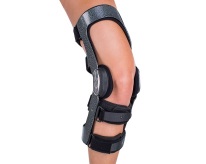
Hinged
A hinged brace is ideal for athletes who need protection and stabilization post-surgery, ACL, MCL or PCL injuries. A bad twist, poor knee to ankle alignment, or wrong way to land are common ways athletes sustain ligament injuries. A hinged brace offers protection to the athlete’s knee, delivering support and stability to heal quickly. Hinges can prevent hyperextension of the knee and offers protection of the ACL, and other ligament injuries, to athletes who don’t want to lose speed by weighing themselves down with a heavy brace.
Hinged knee braces come in two forms: rigid and soft hinged. Soft hinged knee braces are ideal for mild to moderate support whereas rigid hinged knee braces are ideal for moderate to maximum support and offer better protection and stability for contact-sports.
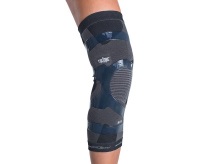
Compression/Sleeves
For mild to moderate chronic knee pain and arthritis can be minimized with sleeves and compression braces. These support braces redistribute the weight-bearing load and increases the ability to perform your best during training and sports, helping decrease pain from day-to-day movement, which is no small feat. Can fit under clothing for daily comfort.
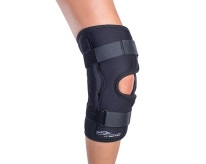
Wraparounds
Wraparound styles for athletes provide bracing solutions for mild to moderate knee pain, patellar instabilities and dislocation. Simple and easy to put on and off, allow you to customize the fit for comfort and knee protection. Wrap-style bracing can be worn during activity allowing you to focus on your performance without all the bulk.

Bands/Straps
Help ease runner's knee pain, patellar tendonitis (jumper’s knee) or acute knee pain with strap and band bracing. These are designed to apply a comfortable, effective pressure on the knee to help alleviate pain. Simple to wear (fits under clothing), and easy to put on, straps can be worn during daily activities and sports.
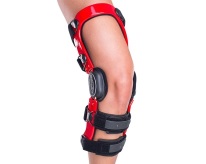
Custom Knee Braces
Custom knee braces are ideal for those looking for a knee brace. Measurements of your knee will be taken and a custom brace will be created for you. We offer custom knee braces available for contact and non-contact sports.
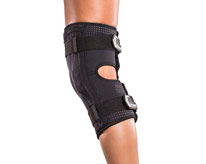
Open vs. Closed Popliteal
The popliteal is located on the back on the knee brace. An open popliteal has a small opening behind the knee which can help keep the body cool when moving. The closed popliteal means there is no opening on the back of the knee. The closed popliteal can help keep the leg warm when moving in cooler temps.
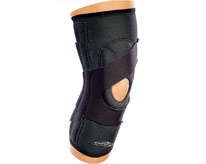
Open vs. Closed Patella
You may see some knee braces with an opening at the knee cap while others are covered. The braces with an open patella help relieve knee pressure and support the knee cap with tracking assistance. A closed patella brace can help offer compression and knee support. If unsure, you can contact our customer support team for assistance, or speak with your doctor on the better option for your needs.
TopWhy and How Do Knee Braces Work for Knee Pain, Injury and Instability?
Whether it’s a knee sprain, arthritis, torn ACL, runner’s knee, knee instabilities or knee discomfort, knee braces help support and manage pain. Depending on the injury will determine how the brace will work. But most braces support the knee and help keep it aligned.
“There are a variety of knee braces out on the market today that are specifically designed to provide relief and support for specific conditions,” says Anna Muñoz, M.Ed., ATC, DonJoy Performance® and DonJoy Advantage® Product Manager. “Knee braces have a variety of features and benefits depending on the condition, you may see a buttress for patella support/tracking, a metal hinge for ligament stability, or compression sleeves for swelling. These design features are incorporated into the brace design to help specifically provide relief and support for the Consumer’s condition.”
When should you start wearing a knee brace?
In general, you can wear a knee brace once you start to experience knee pain or want to prevent a previous knee injury. A knee support can be worn during rehabilitation period like post ACL surgery. It’s best to consult with your primary caregiver about when to wear a knee brace.
TopTop 3 Knee Injuries
The knee joint is complex and made of many muscles and ligaments, which can make it vulnerable to an array of injuries. These knee problems can happen to anyone at any age during any activity. From participating in activity to getting up from the couch or walking, knee injuries can have a big impact on your day-to-day. While wear and tear to the knee happens over time, ligament damage tends to occur from a sudden twist or reactive movement—especially in sports.1 Here are three common knee injuries and which knee braces can help manage symptoms.
Meniscus
The meniscus2 is piece of cartilage that acts like a pad between your femur or thigh bone and tibia or shin bone. A wrong twist can easily injury the C-shape cartilage which can be a partial or total tear. If you experience a small meniscus tear, then the meniscus stays connected to the front and back of the knee. If you have a total tear, then the meniscus may be left hanging by a thread of cartilage. Depending on the size of the tear and location will determine the seriousness of it.
Braces that can help manage a meniscus tear:
-
 $133.36On Sale 0% Off Save $0.00(11) ReviewsCrush lateral instability with dynamic hinged performance. Lightweight Drytex or neoprene wraps, padded polycentric hinges, and popliteal cutout deliver hard-hitting support on every cut and sprint. Whether you’re hitting the field or pounding pavement, stay in the game—no rigid bulk, just fierce confidence.
$133.36On Sale 0% Off Save $0.00(11) ReviewsCrush lateral instability with dynamic hinged performance. Lightweight Drytex or neoprene wraps, padded polycentric hinges, and popliteal cutout deliver hard-hitting support on every cut and sprint. Whether you’re hitting the field or pounding pavement, stay in the game—no rigid bulk, just fierce confidence.The Economy Hinged Knee can be used to treat or prevent the following knee injuries:
- Mild to Moderate MCL/ LCL Injuries
- General Knee Weakness
- Damage to Muscles, Tendons, or Ligaments
- Overuse Injury
-
 Special Price $77.99 Regular Price $86.99On Sale 10% Off Save $9.00(67) ReviewsLock in stability, dominate every move. Polycentric hinges with hyperextension stops + anti-migration wrap-around fit means this brace locks you tight through every jump, cut, and sprint Breathable neoprene, stretch-web closures, stash pocket and reflectivity keep you agile, comfortable, and game-ready—day or night
Special Price $77.99 Regular Price $86.99On Sale 10% Off Save $9.00(67) ReviewsLock in stability, dominate every move. Polycentric hinges with hyperextension stops + anti-migration wrap-around fit means this brace locks you tight through every jump, cut, and sprint Breathable neoprene, stretch-web closures, stash pocket and reflectivity keep you agile, comfortable, and game-ready—day or nightThe Bionic Knee Brace can be used to treat or prevent the following knee injuries:
- MCL and LCL Instabilities
- Knee Hyperextension
- General Meniscus Support
ACL (Anterior Cruciate Ligament) Injury
An ACL tear or sprain is most common during sports that involve sudden stops or change in direction, jumping and landing (such as soccer, basketball, football or downhill skiing). Many athletes hear or feel a "pop" in the knee when an ACL injury occurs. Your knee may swell, feel unstable and become too painful to bear weight.3
Braces that can help manage an ACL injury:
-
 $219.99On Sale 0% Off Save $0.00(32) ReviewsStay in the game with the brace built for explosive movement and serious support. The Bionic Fullstop trains proper ACL motion and protects on every pivot and cut. Trusted by athletes who don’t know the meaning of “slow down.”
$219.99On Sale 0% Off Save $0.00(32) ReviewsStay in the game with the brace built for explosive movement and serious support. The Bionic Fullstop trains proper ACL motion and protects on every pivot and cut. Trusted by athletes who don’t know the meaning of “slow down.”The Bionic FullStop Knee Brace can be used to treat or prevent the following knee injuries:
- ACL Injuries
- Meniscus Injuries
- Moderate Ligament Sprains of MCL, LCL, and PCL
- Patella Support
- Hyperextension Prevention
- Joint Instability
- Post Surgery Protection
-
 Special Price $77.99 Regular Price $86.99On Sale 10% Off Save $9.00(67) ReviewsLock in stability, dominate every move. Polycentric hinges with hyperextension stops + anti-migration wrap-around fit means this brace locks you tight through every jump, cut, and sprint Breathable neoprene, stretch-web closures, stash pocket and reflectivity keep you agile, comfortable, and game-ready—day or night
Special Price $77.99 Regular Price $86.99On Sale 10% Off Save $9.00(67) ReviewsLock in stability, dominate every move. Polycentric hinges with hyperextension stops + anti-migration wrap-around fit means this brace locks you tight through every jump, cut, and sprint Breathable neoprene, stretch-web closures, stash pocket and reflectivity keep you agile, comfortable, and game-ready—day or nightThe Bionic Knee Brace can be used to treat or prevent the following knee injuries:
- MCL and LCL Instabilities
- Knee Hyperextension
- General Meniscus Support
Hyperextended Knee
A hyperextended knee occurs when your knee is pushed past its normal range of motion from a straightened position bending too far back in the wrong direction. While mild knee hyperextension may feel sore and uncomfortable—and can take 2 to 4 weeks to heal—serious knee hyperextension can cause damage to the anterior cruciate ligament (ACL) or posterior cruciate ligament (PCL) and cartilage injuries in the knee, which may require surgery.4
Braces that can help manage hyperextended knee:
-
 Special Price $86.99 Regular Price $95.99On Sale 9% Off Save $9.00(11) ReviewsLock into performance-grade support with bilateral polycentric hinges. Moisture-wicking Drytex material and open-patella design keep you cool, agile, and on‑point through every cut and sprint. Adjustable top/bottom straps and anti-slip silicone hem ensure this brace stays put when you're pushing limits on the field or court.
Special Price $86.99 Regular Price $95.99On Sale 9% Off Save $9.00(11) ReviewsLock into performance-grade support with bilateral polycentric hinges. Moisture-wicking Drytex material and open-patella design keep you cool, agile, and on‑point through every cut and sprint. Adjustable top/bottom straps and anti-slip silicone hem ensure this brace stays put when you're pushing limits on the field or court.The Bionic Drytex Knee Sleeve can be used to treat or prevent the following knee injuries:
- Mild to Moderate MCL/LCL Injuries
- Meniscus Injuries
- Knee Instability
- Sprains and Strains
- Hyperextension
- Arthritis
-
 Special Price $61.99 Regular Price $68.99On Sale 10% Off Save $7.00(3) ReviewsLock in elite-level support through every cut and sprint. Dual aluminum polycentric hinges and hyperextension guards control lateral and medial instability—ideal for ACL, MCL, meniscus, or sprain rehab. Breathable neoprene with moisture-wicking terry lining, wrap-around fit, and anti-slip pads keep it snug, comfortable, and game-ready from kickoff to cool-down .
Special Price $61.99 Regular Price $68.99On Sale 10% Off Save $7.00(3) ReviewsLock in elite-level support through every cut and sprint. Dual aluminum polycentric hinges and hyperextension guards control lateral and medial instability—ideal for ACL, MCL, meniscus, or sprain rehab. Breathable neoprene with moisture-wicking terry lining, wrap-around fit, and anti-slip pads keep it snug, comfortable, and game-ready from kickoff to cool-down .The Bionic Comfort Hinged Knee Brace can be used to treat or prevent the following knee injuries:
- Meniscus Injury
- MCL and LCL Protection
- Knee Instability
- Hyperextension
- Strained Muscles or Tendons
- Sprained Ligaments
-
 $133.36On Sale 0% Off Save $0.00(11) ReviewsCrush lateral instability with dynamic hinged performance. Lightweight Drytex or neoprene wraps, padded polycentric hinges, and popliteal cutout deliver hard-hitting support on every cut and sprint. Whether you’re hitting the field or pounding pavement, stay in the game—no rigid bulk, just fierce confidence.
$133.36On Sale 0% Off Save $0.00(11) ReviewsCrush lateral instability with dynamic hinged performance. Lightweight Drytex or neoprene wraps, padded polycentric hinges, and popliteal cutout deliver hard-hitting support on every cut and sprint. Whether you’re hitting the field or pounding pavement, stay in the game—no rigid bulk, just fierce confidence.The Economy Hinged Knee can be used to treat or prevent the following knee injuries:
- Mild to Moderate MCL/ LCL Injuries
- General Knee Weakness
- Damage to Muscles, Tendons, or Ligaments
- Overuse Injury
Consult your physician if you have experienced any of the above knee injuries. Your doctor will be able to advise you on the best treatment, benefits of using a knee brace, and may prescribe physical therapy exercises to help you recover.
TopProper Knee Brace Fit
Knee braces provide support, stability and more depending on the type of brace. To ensure that you get the benefits of a knee brace, it’s important to have the right fit. Most knee braces will require you to measure three areas: One at knee center, one at the thigh and the other at the calf (6 inches above and below the kneecap). Some supports only require the circumference of the kneecap. We provide sizing guidance, so take a look at the size charts and measuring instructions to get the appropriate size.
When wearing, you’ll want the brace to feel snug, but not so tight that it constricts movement or cuts off circulation. If it feels too tight, you may want to consider a different size. You can consult our bracing experts for additional help.
TopOur Top 10 Best-Selling Knee Braces
Struggling with knee pain? Whether it’s knee instabilities, a ligament injury or runner’s knee, here are our top 10 best-selling knee braces that can help you manage knee pain symptoms and help prevent re-injury.
-
 $150.95On Sale 0% Off Save $0.00(153) ReviewsShock-absorbing elastomeric webbing shifts pain away from your knee. Dual-axis hinges and breathable mesh keep you moving with confidence. Ideal for athletes with patellofemoral pain, Osgood-Schlatter, or mild OA.
$150.95On Sale 0% Off Save $0.00(153) ReviewsShock-absorbing elastomeric webbing shifts pain away from your knee. Dual-axis hinges and breathable mesh keep you moving with confidence. Ideal for athletes with patellofemoral pain, Osgood-Schlatter, or mild OA.The Reaction WEB Knee Brace can be used to treat or prevent the following knee injuries:
- Front of Knee Pain
- Osgood-Schlatter
- Mild Arthritis
- Kneecap Misalignment
- Overuse Injuries
- Muscle Imbalance
- Blunt Trauma
- Runner’s Knee
- Patellar Dislocation
- Chondromalacia
DonJoy® Reaction WEB
Suffering from anterior pain? The DonJoy® Reaction WEB is one of our top solutions to help manage anterior pain. The innovative brace design helps shift weight away from painful areas in the knee. It’s shock-absorbing, flexible and breathable, which is why this brace is one of the best for runner’s knee, jumper’s knee, meniscus tear or instability issues.
DonJoy® Deluxe Hinged Knee
With bilateral hinges for moderate level of support, the DonJoy® Deluxe Hinged Knee brace is best to help active individuals manage ligament instabilities, meniscus injuries, knee sprains, or arthritis.
-
 $90.85On Sale 0% Off Save $0.00(61) ReviewsDominate your day with precision patella alignment. The Tru‑Pull Lite uses a dynamic bifurcated strap and dual-durometer buttress to keep your kneecap locked in proper tracking—even through tight turns and hard sprints. Optimized for athletes and movers, it’s low-profile, breathable, and built to stay put during every play .
$90.85On Sale 0% Off Save $0.00(61) ReviewsDominate your day with precision patella alignment. The Tru‑Pull Lite uses a dynamic bifurcated strap and dual-durometer buttress to keep your kneecap locked in proper tracking—even through tight turns and hard sprints. Optimized for athletes and movers, it’s low-profile, breathable, and built to stay put during every play .The Tru-Pull Lite can be used to treat or prevent the following knee injuries:
- Overuse Injuries
- Muscle Imbalance
- Runner’s Knee
- Blunt Trauma
- Kneecap Misalignment
- Dislocation
- Chondromalacia
- Patellar Tracking Disorder
DonJoy® Tru-Pull Lite™
Ideally suited for runners, weekend warriors or those who need extra support during daily activities, the DonJoy® Tru-Pull Lite provides mild to moderate support for those suffering with patella instabilities, knee dislocations, or knee tracking issues. The Tru-Pull Lite is one of our best knee braces to help reduce pain when it comes to patellofemoral problems.
-
 $56.58On Sale 0% Off Save $0.00(58) ReviewsDominate every direction with the Lateral J-Patella Brace’s reinforced patellar support. Ideal for athletes who battle knee tracking issues, it locks your kneecap in place through every cut and sprint. Stay agile, stay steady, and stay in the game—no matter how fierce the play.
$56.58On Sale 0% Off Save $0.00(58) ReviewsDominate every direction with the Lateral J-Patella Brace’s reinforced patellar support. Ideal for athletes who battle knee tracking issues, it locks your kneecap in place through every cut and sprint. Stay agile, stay steady, and stay in the game—no matter how fierce the play.The Lateral J Patella Knee Brace can be used to treat or prevent the following knee injuries:
- Overuse Injuries
- Muscle Imbalance
- Runner’s Knee
- Blunt Trauma
- Kneecap Misalignment
- Dislocation
- Chondromalacia
- Patellar Tracking Disorder
DonJoy® Lateral J Patella
One of our top patella stabilizing knee braces, the DonJoy® Lateral J Patella has a lateral “J” buttress that runs alongside the knee to provide support against the patellar subluxation. You can wear this brace for daily support, during activity, and water sports.
-
 Special Price $77.99 Regular Price $86.99On Sale 10% Off Save $9.00(67) ReviewsLock in stability, dominate every move. Polycentric hinges with hyperextension stops + anti-migration wrap-around fit means this brace locks you tight through every jump, cut, and sprint Breathable neoprene, stretch-web closures, stash pocket and reflectivity keep you agile, comfortable, and game-ready—day or night
Special Price $77.99 Regular Price $86.99On Sale 10% Off Save $9.00(67) ReviewsLock in stability, dominate every move. Polycentric hinges with hyperextension stops + anti-migration wrap-around fit means this brace locks you tight through every jump, cut, and sprint Breathable neoprene, stretch-web closures, stash pocket and reflectivity keep you agile, comfortable, and game-ready—day or nightThe Bionic Knee Brace can be used to treat or prevent the following knee injuries:
- MCL and LCL Instabilities
- Knee Hyperextension
- General Meniscus Support
DonJoy Performance® Bionic™ Knee
Working best for MCL and LCL support, the DonJoy Performance® Bionic™ Knee can help athletes manage hyperextension and meniscus injuries too. The soft hinges help prevent hyperextension and support knee instabilities.
-
 $219.99On Sale 0% Off Save $0.00(32) ReviewsStay in the game with the brace built for explosive movement and serious support. The Bionic Fullstop trains proper ACL motion and protects on every pivot and cut. Trusted by athletes who don’t know the meaning of “slow down.”
$219.99On Sale 0% Off Save $0.00(32) ReviewsStay in the game with the brace built for explosive movement and serious support. The Bionic Fullstop trains proper ACL motion and protects on every pivot and cut. Trusted by athletes who don’t know the meaning of “slow down.”The Bionic FullStop Knee Brace can be used to treat or prevent the following knee injuries:
- ACL Injuries
- Meniscus Injuries
- Moderate Ligament Sprains of MCL, LCL, and PCL
- Patella Support
- Hyperextension Prevention
- Joint Instability
- Post Surgery Protection
DonJoy Performance® Bionic™ FULLSTOP
Dealing with ACL recovery? The DonJoy Performance® Bionic™ FULLSTOP can help you perform your best with high-quality protection. The Bionic™ FULLSTOP delivers maximum ACL support, has hinges to prevent hyperextension, and can help improve joint mechanics in both surgical and non-surgical knees.
-
 Special Price $43.99 Regular Price $43.99On Sale 0% Off Save $0.00(51) ReviewsEngineered for athletes who demand support without compromise. The TriZone Knee Support combines compression and bracing in a single sleeve, featuring three strategically placed zones for enhanced stability and comfort. Crafted with carbonized bamboo for natural odor control and breathability, it's ideal for sports like basketball, running, and volleyball.
Special Price $43.99 Regular Price $43.99On Sale 0% Off Save $0.00(51) ReviewsEngineered for athletes who demand support without compromise. The TriZone Knee Support combines compression and bracing in a single sleeve, featuring three strategically placed zones for enhanced stability and comfort. Crafted with carbonized bamboo for natural odor control and breathability, it's ideal for sports like basketball, running, and volleyball.The Trizone Knee Support Brace can be used to treat or prevent the following knee injuries:
- Tendonitis
- Meniscus Injury
- Muscle Strain
- Over Use Injury
- Mild Joint Instability
- Need for Compression
DonJoy Performance® Trizone® Knee Brace
When knee pain dampers your performance, it can be address in many ways. The DonJoy Performance® Trizone® Knee Brace combines three essential components of support: compression, cooling, and comfort to help maximize knee pain relief.
-
 Special Price $86.99 Regular Price $95.99On Sale 9% Off Save $9.00(11) ReviewsLock into performance-grade support with bilateral polycentric hinges. Moisture-wicking Drytex material and open-patella design keep you cool, agile, and on‑point through every cut and sprint. Adjustable top/bottom straps and anti-slip silicone hem ensure this brace stays put when you're pushing limits on the field or court.
Special Price $86.99 Regular Price $95.99On Sale 9% Off Save $9.00(11) ReviewsLock into performance-grade support with bilateral polycentric hinges. Moisture-wicking Drytex material and open-patella design keep you cool, agile, and on‑point through every cut and sprint. Adjustable top/bottom straps and anti-slip silicone hem ensure this brace stays put when you're pushing limits on the field or court.The Bionic Drytex Knee Sleeve can be used to treat or prevent the following knee injuries:
- Mild to Moderate MCL/LCL Injuries
- Meniscus Injuries
- Knee Instability
- Sprains and Strains
- Hyperextension
- Arthritis
DonJoy Performance® Bionic™ Drytex™
Working best to help manage medial/lateral ligament protection, knee instabilities, sprains and strains, hyperextension, meniscus injuries, and arthritis, the DonJoy Performance® Bionic™ Drytex™ aids in knee stabilization so you can move comfortably throughout the day and during activity.
-
 $60.04On Sale 0% Off Save $0.00(27) ReviewsThe TriZone Knee Brace combines compression and bracing in a single sleeve, featuring three targeted zones for optimal support. Crafted with carbonized bamboo for cooling and antimicrobial properties, it's designed to keep you moving through repetitive motion injuries.
$60.04On Sale 0% Off Save $0.00(27) ReviewsThe TriZone Knee Brace combines compression and bracing in a single sleeve, featuring three targeted zones for optimal support. Crafted with carbonized bamboo for cooling and antimicrobial properties, it's designed to keep you moving through repetitive motion injuries.The TriZone Knee Brace can be used to treat or prevent the following knee injuries:
- Meniscus Injury
- Tendonitis
- Muscle Strain
- Over Use Injury
- Mild Joint Instability
- Need for Compression
DonJoy® Trizone® Knee Sleeve
A hybrid design, the DonJoy® Trizone® Knee Sleeve combines three zones of compression around the knee joint and bracing in a single sleeve. The Trizone® Knee Sleeve is a low-profile performance product that will help you move in comfort and support.
-
 Special Price $34.99 Regular Price $38.99On Sale 10% Off Save $4.00(18) ReviewsTargeted Relief for Peak Performance Innovative silicone web applies even pressure to the patellar tendon, alleviating runner's knee discomfort. Lightweight, contoured design with breathable back pad ensures comfort during intense activities.
Special Price $34.99 Regular Price $38.99On Sale 10% Off Save $4.00(18) ReviewsTargeted Relief for Peak Performance Innovative silicone web applies even pressure to the patellar tendon, alleviating runner's knee discomfort. Lightweight, contoured design with breathable back pad ensures comfort during intense activities.The Webtech Knee Strap can be used to treat or prevent the following knee injuries:
- Overuse Injuries
- Patella Tracking Disorder
- Muscle Imbalance
- Strained Muscle or Tendons
- Mild Sprains
- Blunt Trauma
DonJoy Performance® Webtech™ Knee Strap
An innovative knee strap that combines compression and silicone web, the DonJoy Performance® Webtech™ knee strap distributes pain-relieving pressure on the Petellar Tendon. The Webtech™ Knee Strap is one of our best tools for overcoming runner’s knee.
Note: Top braces are based on our top-selling knee braces
TopNeed More Help?
Our bracing experts will help you identify the best brace from our bracing collection, whether you need support for preventative care, daily use or sports. Shop our Knee Braces or check out our Brace Advisor for a shopping guide.
TopSources











